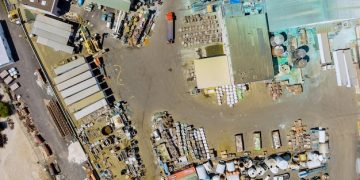The Impact of US Economic Policies on International Aid Organizations: A 2025 Analysis

The Impact of US Economic Policies on International Aid Organizations: A 2025 Analysis reveals how changes in US financial regulations, trade laws, and foreign aid budgets can significantly influence the operational effectiveness of international aid organizations by affecting their funding, logistical capabilities, and strategic planning.
Understanding the impact of US economic policies on international aid organizations: a 2025 analysis is more crucial than ever as these policies shape the global landscape of humanitarian aid. Join us as we delve into how these shifts affect aid distribution and organizational strategies.
How US Economic Policies Affect International Aid
The influence of US economic policies on international aid organizations is substantial. These policies, encompassing everything from trade agreements to financial regulations, establish the framework within which these organizations operate, affecting their funding, resources, and overall effectiveness.
Let’s explore specific ways in which US economic policies are impacting international aid, offering insights into both the challenges and opportunities these present.
Funding Fluctuations
US economic policies can lead to significant fluctuations in the funding available to international aid organizations. Changes in budget allocations, tax policies, and trade relationships can all impact the financial resources at their disposal.
Operational Challenges
Beyond funding, US economic policies can also impose operational challenges. Regulations around procurement, shipping, and compliance can create bureaucratic hurdles that slow down aid delivery and increase costs.
- Trade policies can impact the cost of essential goods, affecting aid budgets.
- Sanctions can restrict access to certain regions, complicating aid delivery.
- Changes to tax laws can affect donations from US individuals and corporations.
Ultimately, understanding these impacts is essential for international aid organizations to adapt and remain effective in their missions.

The Role of Trade Agreements
Trade agreements are a cornerstone of US economic policy and have significant effects on international aid organizations. These agreements affect the prices of goods, regulate market access, and can promote or hinder economic development in aid-receiving countries.
By understanding these dynamics, we can better grasp how trade policies affect global aid efforts.
Impact on Local Economies
Trade agreements can impact local economies, creating either opportunities or challenges for aid organizations. Agreements that promote economic growth can reduce the need for aid, while those that harm local producers can increase dependence on external assistance.
Ensuring Fair Trade
Aid organizations often grapple with the need to ensure fair trade practices, especially when US trade policies seem to disadvantage developing countries. Advocacy for policy changes and support for sustainable trade are common strategies.
- Implementing trade policies that support sustainable development.
- Ensuring aid does not undermine local market competitiveness.
- Monitoring the impact of trade agreements on vulnerable populations.
The intersection of trade agreements and international aid requires a nuanced approach, balancing economic interests with humanitarian goals.
Foreign Aid Budgets and Allocations
US foreign aid budgets and allocations are direct reflections of its economic policies. These budgets dictate how much funding is available for international aid, which countries receive assistance, and what types of programs are prioritized.
Examining these allocations provides insights into the United States’ global priorities and its commitment to humanitarian efforts.
Shifting Priorities
US foreign aid priorities can shift based on political, economic, and security considerations. Understanding these shifts is crucial for aid organizations to adapt their strategies and maintain funding.
Aid Effectiveness
Ensuring aid effectiveness is a key concern for both policymakers and aid organizations. This involves measuring the impact of aid programs, promoting accountability, and adapting strategies based on results.
- Strategic alignment of aid programs with US foreign policy goals.
- Allocations towards sustainable development initiatives.
- Support for long-term capacity building in developing nations.
Effective management of foreign aid budgets is vital for maximizing the impact of US economic policies on global development.
The Influence of Financial Regulations
US financial regulations play a critical role in the operations of international aid organizations. These regulations govern how organizations can receive, manage, and distribute funds, ensuring compliance and preventing illicit activities.
Understanding these regulations is essential for maintaining transparency and maximizing the impact of aid efforts.
Compliance Costs
Compliance with US financial regulations can be costly and time-consuming for aid organizations. Navigating complex rules and reporting requirements can divert resources from core programs.
Transparency and Accountability
While compliance can be burdensome, it also promotes transparency and accountability. This is critical for maintaining public trust and ensuring that aid funds are used effectively and ethically.
- Simplifying compliance procedures for smaller organizations.
- Implementing technology to streamline reporting.
- Enhancing collaboration between regulators and aid organizations.
Balancing regulatory oversight with the need for efficient aid delivery is an ongoing challenge in the sector.

Challenges and Opportunities for Aid Organizations
The intersection of US economic policies and international aid presents a complex landscape of challenges and opportunities for aid organizations. Understanding these dynamics is essential for developing effective strategies and maximizing impact.
From adapting to policy changes to leveraging new funding sources, aid organizations must navigate a shifting landscape.
Adapting to Policy Shifts
Aid organizations must be agile and adaptable in the face of shifting US economic policies. This requires staying informed, building relationships with policymakers, and diversifying funding sources.
Leveraging Private Funding
With potential cuts in government aid, leveraging private funding is becoming increasingly important. This involves developing innovative fundraising strategies, building partnerships with corporations, and engaging individual donors.
- Advocating for policies that support aid effectiveness.
- Diversifying funding streams to reduce reliance on US aid.
- Building strong local partnerships to enhance aid delivery.
By embracing innovation and collaboration, aid organizations can overcome challenges and continue to make a meaningful impact.
Strategies for Navigating US Economic Policies in 2025
As we look ahead to 2025, it is crucial for international aid organizations to develop robust strategies for navigating US economic policies. This involves proactive engagement, strategic partnerships, and a focus on sustainable solutions.
Let’s explore some key strategies for success in this evolving landscape.
Proactive Engagement
Proactive engagement with US policymakers is essential for influencing policy decisions and ensuring that aid organizations’ voices are heard. This includes advocacy, lobbying, and public education campaigns.
Sustainable Solutions
Focusing on sustainable solutions is critical for long-term impact. This involves investing in local capacity building, promoting economic development, and addressing the root causes of poverty and inequality.
- Building strong relationships with US government officials.
- Investing in data and research to inform policy advocacy.
- Strengthening local capacity to enhance long-term sustainability.
By adopting these strategies, international aid organizations can navigate the complexities of US economic policies and continue to make a positive difference in the world.
| Key Aspect | Brief Description |
|---|---|
| 💸 Funding | US policies affect aid org funding via budget allocations. |
| 🤝 Trade | Trade deals shape aid effectiveness in recipient nations. |
| 📜 Regulations | Financial rules impact how aid is managed and distributed. |
| 🌍 Sustainability | Focus shifts to long-term local solutions for aid effectiveness. |
FAQ
▼
US economic policies, particularly budget allocations and tax regulations, directly impact the amount of funds available for international aid organizations. Changes can lead to fluctuations in their operational budgets.
▼
Trade agreements define market access and affect commodity prices, influencing the economic conditions in aid-receiving countries. They can either support or hinder the efforts of aid organizations.
▼
Financial regulations ensure transparency and accountability in how aid funds are managed and distributed, which is crucial for preventing fraud and maintaining public trust in these organizations.
▼
Aid organizations can proactively engage with policymakers, diversify their funding sources, and build strong local partnerships to adapt to changing US economic policies effectively.
▼
Sustainability ensures long-term impact by focusing on local capacity building and addressing the underlying causes of poverty and inequality, making aid efforts more effective and durable.
Conclusion
In conclusion, understanding the intricate relationship between US economic policies and international aid organizations is crucial for stakeholders seeking to maximize aid effectiveness and promote sustainable global development. As we move towards 2025 and beyond, proactive engagement, strategic partnerships, and a focus on sustainability will be key for navigating this complex landscape and ensuring that aid efforts continue to make a positive impact on the world’s most vulnerable populations.





